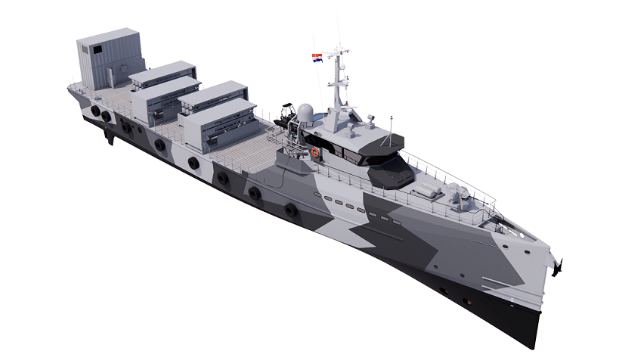Dutch Navy Buys Two Missile-Carrying "Support Vessels" to Boost Firepower

The Royal Netherlands Navy plans to supplement the firepower of its frigate force with lightly-manned follow-along missile boats - a rare real-life procurement of this modern vessel class, similar in concept to the U.S. Navy's proposed LUSV.
The Dutch defense ministry announced Wednesday that it is buying two "support vessels" that will accompany its frigates into higher-risk areas. The Damen-built vessels will not be complete all-domain surface combatants in their own right, as they will be reliant on the frigate's radar detection and targeting capabilities for the high-end fight. Instead, the smaller escort will augment the frigate's missile cell capacity for operating in "higher violence spectrum" scenarios - particularly air defense situations, like the high-tempo antimissile/antidrone capability required in the Red Sea.
In between air defense missions, the support vessels are equipped for a seabed monitoring role, helping detect and deter emerging threats to North Sea subsea infrastructure.
"Floating toolboxes. That's what you could call the two new multifunctional support vessels for the [Dutch navy]," said Dutch defense minister Gijs Tuinman in a statement.
The two missile boats are similar in appearance to Damen's fast patrol boat designs, with a sheer bow, slender beam and fendering along the parallel midbody. According to the ministry, they will be fitted IRI's Barak ER (Barak-8 ER) surface-to-air missile and the Harop loitering munition.
Harop is canister-launched and has a flying time of up to six hours, and it has a proven operational history of use against Armenian forces in Nagorno-Karabakh. Barak-8 ER is a supersonic antiaircraft missile with a range of up to about 75 nautical miles, and is highly maneuverable for intercepting supersonic antiship missiles, ballistic missiles and unmanned drones. It is designed for multiple simultaneous engagements (swarms), and can be launched from a vertical launch cell or a canister mount for shipboard installation. The ministry's illustration suggests that the armament will be mounted abovedecks in modular canister racks.
Both vessels will be online for their North Sea subsea mission from 2026 and will be fully available for all missions in 2027.
